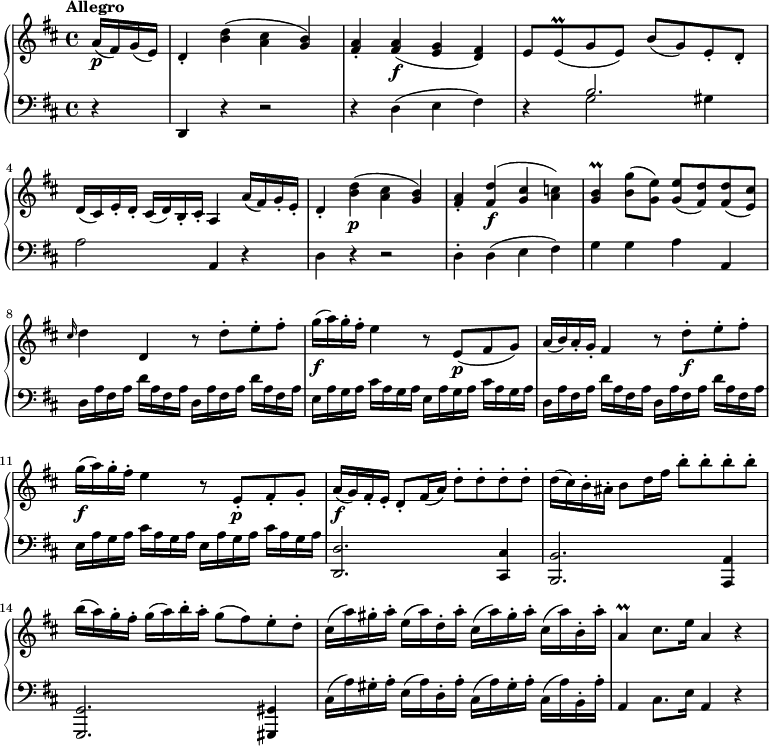|
Three Piano Sonatas, WoO 47 (Beethoven)
The Three Piano Sonatas, WoO 47, were composed by Ludwig van Beethoven probably between 1782 and 1783, when he was between twelve and thirteen years old.[1] The sonatas show a certain level of precocity and serve as a precursor to the masterworks he later produced. They are dedicated to the Prince-elector (German: Kurfürst) Maximilian Friedrich[2] and therefore also known as the Kurfürstensonaten. OverviewLike Mozart's, Beethoven's musical talent was recognized at a young age,[3] and these three piano sonatas give an early glimpse of the composer's abilities, as well as his boldness. Beethoven was writing in a form usually attempted by older, more mature composers,[4] as the sonata was a cornerstone of Classical piano literature. Since they were written at such an early age (and Beethoven himself did not assign them opus numbers), the works have historically been omitted from the canon of Beethoven's piano sonatas. However, Barry Cooper included the trio in his critical edition of the sonatas created for ABRSM, arguing that "A complete edition has to be complete, and if you ignore early works, you don't show the longer trajectory of the composer's development."[5] The inclusion of these three works raises Beethoven's total number of piano sonatas from 32 to 35.[a][6] The sonatasNo. 1 in E♭ major
The second theme of the first movement closely resembles part of the first, so that in the recapitulation the first theme can be omitted entirely without its absence being noticed. One of the main characteristics of Beethoven's thought is evident in this sonata: the development of a multitude of contrasting motifs and characters from a basic cell. The liveliness of the Rondo reveals Beethoven's evident pleasure in his own virtuosity.
No. 2 in F minor
The musical ideas are individualized in this sonata, where the strongest emotions are expressed. In the conception of the time, the key of F minor is perceived as severe and passionate, and Beethoven would return to this character later, especially in the Sonatas Op. 2 No. 1 and Op. 57. The first movement, deeply Beethovenian, begins with a slow introduction that makes abundant use of contrasting registers. The appearance of the main theme through repetitions and the change of tempo to allegro already prefigure the Pathétique Sonata. The Presto, with its unison passages and its agitated lines, puts a passionate end to this remarkable work, written by a child.
No. 3 in D major
In the first movement the second theme is introduced as expected, in the dominant, but in the recapitulation it reappears after only four bars, and in the key of G major rather than D major, creating interesting ambiguities about its true status. The Menuetto has six variations, the fourth of which is technically difficult to play in minuet tempo. The composer again uses G major as a substitute for D major in part of the finale, thus establishing a large-scale tonal relationship of the kind normally associated with the mature Beethoven. The humorous sentiment suggested in the Scherzando was to become a regular feature of Beethoven's work.
See alsoReferencesNotes
Citations
Sources
Further reading
External links |
||||||||||||||||

![{
\new PianoStaff <<
\new Staff \relative c'' { \clef treble
\key aes \major
\tempo "Largetto Maestoso" 4 = 60
\set Score.tempoHideNote = ##t
\time 2/2
|
<f,\f aes c f>2\arpeggio
f8.\prall f16 f4
|
f8\p( aes) aes-. aes-.
aes\prall( g) g( f)
|
<<c'2\f e2 g2 c2>>
c,8.\prall c16 c4
|
g8(\p bes8) bes8-. bes-.
bes( aes) aes( g)
|
<<f2\ff f'2>>
r8
<<f,8-.\p f'8>>
<<f,8-. f'8>>
<<f,8-. f'8>>
|
<<f,8( f'8>>
<<ges,8) ges'8>>
<<ges,4\f ges'4>>
r8
<<ges,8-.\p ges'8>>
<<ges,8-. ges'8>>
<<ges,8-. ges'8>>
|
<<ges,8( ges'8>>
<<a,8) a'8>>
<<a,4\f a'4>>
r8
<<a,8-.\p a'8>>
<<a,8-. a'8>>
<<a,8-. a'8>>
|
<<bes,8\pp bes'8>>
<<f8 f'8>>
<<des,8 des'8>>
<<bes,8 bes'8>>
<<f,8 f'8>>
\hideNotes
r4.
|
r1
\unHideNotes
}
\new Staff \relative c { \clef bass
\key aes \major
|
<<f,2 f'2>>
<<f8. aes8.>>
<<f16 aes16>>
<<f4 aes4>>
|
<<\new Voice{\voiceTwo
f1
}
\new Voice{\voiceOne
aes8(
c8)
c8-.
c8-.
c8(
bes8)
bes8(
aes8)
}>>
|
<<c,2 e2 g2 c2>>
c,8.
c16
c4
|
\clef treble
<<\new Voice{\voiceTwo
c'1
}
\new Voice{\voiceOne
e8(
g8)
g8-. g8-.
g8( f8)
f8( e8)
}>>
|
\clef bass
aes,,,16 f'16 e16 f16
aes16 f16 e16 f16
aes,16 f'16 e16 f16
aes16 f16 e16 f16
|
bes,16 bes'16 a16 bes
des bes a bes
bes, bes' a bes
des bes a bes
|
c, c' b c
ees c b c
c, c' b c
ees c b c
|
<<\new Voice{\voiceTwo
<<des1 des,1>>
|
c2\fermata
c4
c4\rest
}
\new Voice{\voiceOne
\hideNotes
r2
r8
\unHideNotes
aes''8^[_( g8 <<f8] b8)>>
|
<<f2 b2\fermata>>
<<c4 g4 e4>>
aes4\rest
}>>
|
}>>
}](http://upload.wikimedia.org/score/d/i/di3ge3yv94sw6hao3s7aa61ejemk3hn/di3ge3yv.png)
